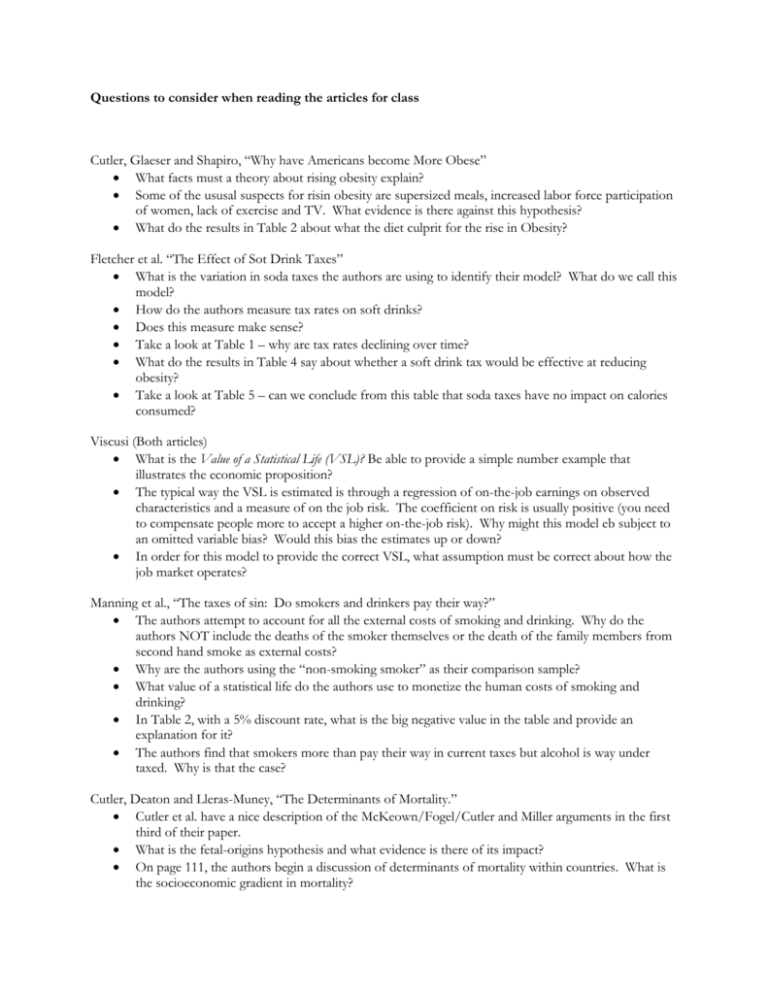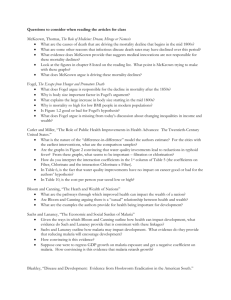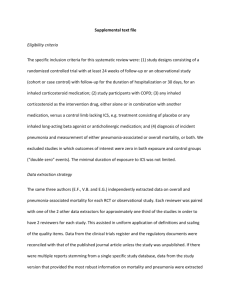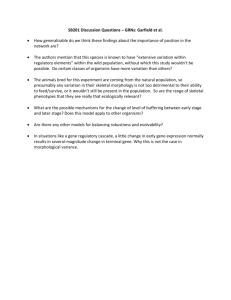Questions to consider for readings
advertisement

Questions to consider when reading the articles for class Cutler, Glaeser and Shapiro, “Why have Americans become More Obese” What facts must a theory about rising obesity explain? Some of the ususal suspects for risin obesity are supersized meals, increased labor force participation of women, lack of exercise and TV. What evidence is there against this hypothesis? What do the results in Table 2 about what the diet culprit for the rise in Obesity? Fletcher et al. “The Effect of Sot Drink Taxes” What is the variation in soda taxes the authors are using to identify their model? What do we call this model? How do the authors measure tax rates on soft drinks? Does this measure make sense? Take a look at Table 1 – why are tax rates declining over time? What do the results in Table 4 say about whether a soft drink tax would be effective at reducing obesity? Take a look at Table 5 – can we conclude from this table that soda taxes have no impact on calories consumed? Viscusi (Both articles) What is the Value of a Statistical Life (VSL)? Be able to provide a simple number example that illustrates the economic proposition? The typical way the VSL is estimated is through a regression of on-the-job earnings on observed characteristics and a measure of on the job risk. The coefficient on risk is usually positive (you need to compensate people more to accept a higher on-the-job risk). Why might this model eb subject to an omitted variable bias? Would this bias the estimates up or down? In order for this model to provide the correct VSL, what assumption must be correct about how the job market operates? Manning et al., “The taxes of sin: Do smokers and drinkers pay their way?” The authors attempt to account for all the external costs of smoking and drinking. Why do the authors NOT include the deaths of the smoker themselves or the death of the family members from second hand smoke as external costs? Why are the authors using the “non-smoking smoker” as their comparison sample? What value of a statistical life do the authors use to monetize the human costs of smoking and drinking? In Table 2, with a 5% discount rate, what is the big negative value in the table and provide an explanation for it? The authors find that smokers more than pay their way in current taxes but alcohol is way under taxed. Why is that the case? Cutler, Deaton and Lleras-Muney, “The Determinants of Mortality.” Cutler et al. have a nice description of the McKeown/Fogel/Cutler and Miller arguments in the first third of their paper. What is the fetal-origins hypothesis and what evidence is there of its impact? On page 111, the authors begin a discussion of determinants of mortality within countries. What is the socioeconomic gradient in mortality? How persistent is the gradient across countries? Across causes of death? Across measures of socioeconomic status? What are some possible explanations for this gradient? Why do these “usual suspects” not explain the SES/health gradient? How might the SES/health relationship be driven by “reverse causation”? What is the evidence that the gradient may be driven by social status and stress? Clark and Royer, “The Effect of Education on Adult Mortality and Heath: Evidence from Britain.” What is the 1944 Education Act and what did it do? Look at Figure 1 – is the fact that the law did not change college enrollment or high school completion good or bad for the authors? Interpret the results in Figure 3 – what do these say about the impact of education on mortality? What assumptions must be correct for the authors to be able to call the estimates in Table 3 a causal estimate of education on mortality? Sullivan and von Wachter, “Job Displacement and Mortality: An Analysis Using Administrative Data.” The authors examine the impact of displacement on mortality. How is displacement defined and wht do they focus on this instead of simply “job loss”? Look at Figure I. What does this say about the income loss associated with displacement. In Figure I, what is happeneing to wages before displacement Givent he definition of displacement, does this pattern of wages make sense? What is the sample used to construct Figure I and what are the limitations of this sample? The primary results that estimate the impact of displacement on mortality are found in Table IV. Look at the 1st column of results. What does the pattern of results suggest and do these resuts make sense? An important question is whether the heightened mortality after job loss is due to the stress of job loss itself or the loss of income. Look at the pattern of results in the top panel of Figure III. Interpret what this Figure implies wanmd what does this mean about the impact of income loss as an explantion for the rise in mortality after displacement. Gardner and Oswald Who is in the comparison sample in this case? Is this high or low external validity for this estimate? Table a look at Table 1. What is the primary limitation of this paper? The previous two papers use mortality as an outcome. Why don’t the authors use mortality as an outcome in this case? Given the Adler et al. article, is stress a good outcome in this case? Bloom and Canning, “The Heath and Wealth of Nations” What are the pathways through which improved health can impact the wealth of a nation? Are Bloom and Canning arguing there is a “casual” relationship between health and wealth? What are the examples the authors provide for health being important for development? Sachs and Lananey, “The Economic and Social Surden of Malaria” Given the ways in which Bloom and Canning outline how health can impact development, what evidence do Sach and Lananey provide that is consistent with these linkages? Sachs and Lananey outline how malaria may impact development. What evidence do they provide that reducing malaria will encourage development? How convincing is this evidence? Suppose one were to regress GDP growth on malaria exposure and get a negative coefficient on malaria. How convincing is this evidence that malaria retards growth? Bleakley, “Disease and Development: Evidence from Hookworm Eradication in the American South.” What is the Rockefeller sanitation commission? Why might hookworm infection impact education outcomes? In attempting to determine whether hookworm eradication improved outcomes, what is the key assumption the author makes in the statistical model? Why is table IV important for the authors? Given the results in this article, are they suggestive that improved health can lead to greater economic development? Cutler et al., “Early-life Malaria Exposure and Adult Outcomes: Evidence from Malaria Eradication in India,” Although they are dealing with a different disease in a different county in a different time, there are a lot of similarities between this and the Bleakley paper. What are they? What is the key assumption the authors are making in orer for them to obtain unbiased estimates in their difference-in-difference model? Why is the 1959-1060 regression line in Figure 3? Are the results in this paper supportive of the hypothesis put forward in Sachs and Lananey? Acemoglu and Johnson, "Disease and Development: The Effect of Life Expectancy on Economic Growth" What is the international epidemiological revolution? What are the advances that drive mortality decline that came with this revolution? How do Figures 1 and 2 explain the basic results in this paper? For the authors basic argument they spend a great deal of time arguing that the declines in mortality associated with the IDR are ‘exogenous’ – what does this mean and why is it important for the author’s argument? Can you follow the math in equations (1) – (4)? What do the results from this paper suggest may be the impact of the AIDS crisison economic growth in Africa? Provide an intuitive economic argument that summarizes the empirical results in Tables 2 and 3, that is consistent with the economic model in equations (1)-(4). Why might the results in Table 2 be subject to an omitted variables bias? McKeown, Thomas, The Role of Medicine: Dream, Mirage or Nemesis What are the causes of death that are driving the mortality decline that begins in the mid 1800s? What are some other reasons that infectious disease death rates may have declined over this period? What evidence does McKeown provide that suggests medical innovations are not responsible for these mortality declines? Look at the figures in chapter 8 listed on the reading list. What point is McKeown trying to make with these graphs? What does McKeown argue is driving these mortality declines? Fogel, The Escape from Hunger and Premature Death What does Fogel argue is responsible for the decline in mortality after the 1850s? Why is body size important factor in Fogel’s argument? What explains the large increase in body size starting in the mid 1800s? Why is mortality so high for low BMI people in modern populations? Is Figure 1.2 good or bad for Fogel’s hypothesis? What does Fogel argue is missing from today’s discussion about changing inequalities in income and wealth? Cutler and Miller, “The Role of Public Health Improvements in Health Advances: The Twentieth-Century United States.” What is the nature of the “difference-in-difference” model the authors estimate? For the cities with the earliest interventions, what are the comparison samples? Are the graphs in Figure 2 convincing that water quality investments lead to reductions in typhoid fever? From these graphs, what seems to be important – filtration or chlorination? How do you interpret the interaction coefficients in the 1st column of Table 5 (the coefficients on Filter, Chlorinate and the interaction Chlorinate x Filter). In Table 6, is the fact that water quality improvements have no impact on cancer good or bad for the authors’ hypothesis? In Table 10, is the cost per person year saved low or high?








